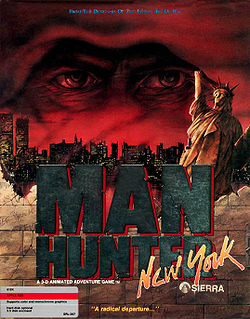- Manhunter: New York
-
Manhunter: New York 
Developer(s) Evryware Publisher(s) Sierra Entertainment Platform(s) MS-DOS, Amiga, Atari ST, Apple IIGS, Tandy 1000 Release date(s) 1988 Genre(s) Adventure game Mode(s) Single player Manhunter: New York is a post-apocalyptic adventure game designed by Barry Murry, Dave Murry and Dee Dee Murry of Evryware and published in 1988 by Sierra On-Line. A sequel, Manhunter 2: San Francisco was released the next year in 1989
Contents
Scenario
It is set in the (then) futuristic year of 2004, when Earth has been enslaved by a race of aliens known as the Orbs. The Orbs, who look like giant floating eyeballs, have implanted all humans with global tracking devices, forced them to wear nondescript robes and forbid them from speaking or communicating. The protagonist has been assigned by the Orbs to track down fellow humans who are believed to be forming an underground resistance. Over the course of the game, the player discovers that the Orbs are not the benevolent rulers they claim to be; they are actually harvesting humans as a food source. The player then "switches sides" and works to overthrow the Orbs.
Gameplay
Manhunter: New York used Sierra's Adventure Game Interpreter (AGI) development tool. It was very different from other AGI games in that it did not use a text parser, incorporated a first-person rather than third-person perspective, and featured a rudimentary point-and-click interface. In these ways, Manhunter foreshadowed later games like Myst. The gritty, sometimes gory visuals, unique interface, and use of real-life locations in New York City all helped set the game apart from Sierra's other titles, which were typically more family oriented.
The game had no live dialogues. Much of the gameplay had to do with tracking individuals with his MAD device and 'unlock' new places and addresses. The backstory and plot remain vague and obscure; the player had to put the pieces of the movements together in his head, instead of reading a narrative or descriptions, and understand on his own what is happening.
One of the criticisms concerning the interface was that the cursor/pointer was not controlled by the mouse, but by the keyboard. The mouse, if the player decided to use it, was only to point out where the cursor must go.
A follow-up game, Manhunter 2: San Francisco (1989), continued the story. By that time, Sierra had unveiled their more impressive Sierra's Creative Interpreter (SCI) development system. Despite offering up a more complex storyline, Manhunter 2: SF used the older AGI development system.
The Manhunter series was originally conceived as a trilogy, with all plots threads and loose ends to be tied up in the third game – Manhunter 3: London. However, the series was dropped after the second game and was never resumed. The Murrys also had plans for a fourth and final game (Manhunter 4) – if Sierra wanted one – to be set not on Earth but on the Orbs' home planet.
Contrary to popular belief, the Manhunter series was not discontinued owing to poor sales or lack of consumer interest.[citation needed] The games were critically acclaimed and sold well,[citation needed] and the series was never (and still has not been) officially canceled. However, since more than two decades have passed since Manhunter 2: San Francisco was released, it is extremely unlikely that the series will ever be completed.
Real-World Locations
- American Museum of Natural History
- Bellevue Hospital
- Central Park
- Coney Island
- Empire State Building
- Grand Central Terminal
- Green-Wood Cemetery
- Prospect Park (Brooklyn)
- Statue of Liberty
- Trinity Church (Manhattan)
External links
- Manhunter: New York – Adventure Classic Gaming Game Information & Screenshots
- Evryware' s official website
- Manhunter: New York at MobyGames
- The Manhunter Shrine
Categories:- Video game franchises
- 1988 video games
- Adventure games
- Sierra Entertainment games
- ScummVM supported games
- Video games set in New York City
- Amiga games
- Apple IIGS games
- Atari ST games
- DOS games
Wikimedia Foundation. 2010.
